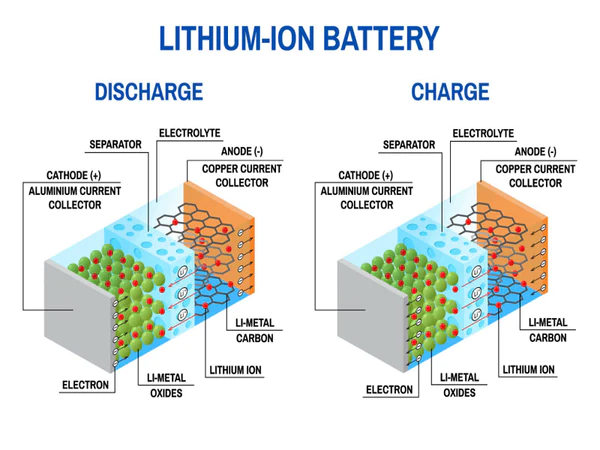The future of battery storage is a critical component in the global transition towards sustainable energy systems and the electrification of transportation. Lithium-ion (Li-ion) batteries have dominated this landscape due to their high energy density, longevity, and efficiency. However, as demand for energy storage solutions grows, alternative battery technologies are emerging, offering different advantages and addressing some of the limitations of Li-ion batteries. This comparison delves into the future of battery storage, juxtaposing lithium-ion technology against its competitors, including solid-state, lithium-sulfur, sodium-ion, and flow batteries, among others.

Lithium-Ion Batteries
Advantages:
- High Energy Density: Enables longer ranges for electric vehicles (EVs) and compact storage solutions.
- Mature Technology: Well-established manufacturing processes and a broad base of applications from portable electronics to grid storage.
- Fast Charging Capabilities: Suitable for applications requiring quick recharge times.
Limitations:
- Resource Constraints: Reliance on scarce materials like lithium and cobalt raises concerns about supply chain sustainability.
- Safety Issues: Risk of thermal runaway and fires necessitates complex management systems.
- Environmental Impact: Mining and processing of materials have significant environmental footprints.
Solid-State Batteries
Advantages:
- Enhanced Safety: Solid electrolytes are less flammable, reducing the risk of thermal runaway.
- Higher Energy Density: Potential to surpass Li-ion batteries, offering longer EV ranges and more compact storage.
- Longer Lifespan: Less prone to degradation over repeated charge-discharge cycles.
Limitations:
- Manufacturing Challenges: High production costs and technical hurdles in scaling up.
- Material Issues: Requires further development to identify solid electrolytes that are both conductive and durable.
Lithium-Sulfur Batteries
Advantages:
- Higher Theoretical Energy Density: Offers the possibility of even longer ranges for EVs than Li-ion.
- Abundant Materials: Sulfur is plentiful and more environmentally friendly.
- Cost-Effectiveness: Potentially cheaper due to the low cost of sulfur.
Limitations:
- Shorter Lifecycle: Suffers from rapid capacity fade due to polysulfide dissolution.
- Technical Challenges: Requires development to stabilize the electrode materials and improve longevity.
Sodium-Ion Batteries
Advantages:
- Abundant Resources: Sodium is more abundant and cheaper than lithium.
- Environmental Benefits: Less harmful mining and processing impact.
- Versatility: Can be used in a wide range of temperatures and applications.
Limitations:
- Lower Energy Density: Currently, offers lower energy density compared to Li-ion, limiting its use in weight-sensitive applications like EVs.
- Development Stage: Still in the early stages of commercialization, requiring further advancements to match Li-ion performance.
Flow Batteries
Advantages:
- Scalability: Energy capacity is independent of power output, making it ideal for large-scale energy storage.
- Long Duration: Capable of storing energy for several hours to days, suitable for grid applications.
- Safety and Lifespan: Low risk of thermal events and degradation over time.
Limitations:
- Complexity and Size: More complex and larger than solid-state batteries, limiting use in portable applications.
- Energy Density: Lower energy density makes them unsuitable for applications where space is a constraint.
The Future of Battery Storage
The landscape of battery technology is rapidly evolving, with each type offering distinct advantages and challenges. Lithium-ion batteries are likely to remain a cornerstone of energy storage and EV markets in the near term, thanks to ongoing improvements in performance and cost. However, the development and commercialization of alternative battery technologies are poised to address the limitations of Li-ion batteries, particularly concerning safety, resource sustainability, and energy density.
Solid-state batteries, in particular, represent a significant breakthrough potential, promising higher energy densities and safety profiles. Meanwhile, technologies like lithium-sulfur and sodium-ion batteries offer avenues to mitigate resource scarcity and environmental concerns. Flow batteries are emerging as a viable solution for stationary storage, complementing the variability of renewable energy sources.
As the demand for energy storage continues to grow, driven by the global push for decarbonization and electrification, the battery industry’s future will likely be characterized by diversification. Innovations in battery chemistry, materials science, and manufacturing technologies will play critical roles in shaping the energy storage solutions of tomorrow, making them safer, more efficient, and sustainable.
